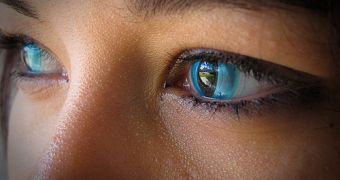A new method to fight bacterial infections associated with contact lenses, that can also be used in bacterial infections related to severe burns or cystic fibrosis, has been developed and successfully tested by researchers at National Jewish Health and the University of Texas Southwestern Medical Center.
The eye has several mechanisms by which it fights infections, and this includes blinking, which remove the bacterial organisms from the surface of the eyes.
But for those who wear contact lenses, blinking is no longer effective, because bacteria can adhere to the surface of the contact lens that sits against the eye.
If these bacteria infect the surface of the cornea, thy can destroy the corneal cells and lead to scarring and vision loss.
This condition is called microbial keratitis and it affects two to four contact lenses wearers per 10,000, every year.
Senior author Jerry Nick, MD, Associate Professor of Medicine at National Jewish Health, explained that “infections by the bacteria Pseudomonas aeruginosa can cause severe scarring and vision loss when they spread to the cornea.
“By breaking apart a molecular scaffolding that encases the organisms and makes them more difficult to eradicate, we were able to significantly reduce bacterial infection of the cornea.”
Normally, eye infections can be treated with antibiotics, but eliminating bacteria from contact lenses can be rather difficult, especially if they form a biofilm.
A biofilm of bacteria contains whole communities of the organism, and this makes them much more difficult to destroy.
Earlier findings according to which cellular debris from immune cells fighting the infection become raw materials for the biofilm (actin, DNA and histones), have been confirmed by the researchers.
So, to break down the chemical bonds of these elements supporting the biofilm, they used the enzyme DNAase, along with negatively charged poly aspartic acid.
This approach reduce biofilms on contact lenses by 79.2%, and decreased infection of the cornea in an animal model by 41%.
To complete these good news, there was no evidence of any damage caused by the treatments.
Danielle Robertson, OD, PhD, first author and Assistant Professor of Ophthalmology at UT Southwestern, and first author on the study, said that “these are very promising early results that point to potentially new methods for removing bacterial biofilms from contact lens surfaces, thereby reducing the risk of microbial keratitis, as well as the for the treatment of infections by Pseudomonas that are associated with cystic fibrosis and severe burns.”
The results were published in the journal Investigative Ophthalmology and Visual Science.

 14 DAY TRIAL //
14 DAY TRIAL //